|


Editorial
|
Fragments
|
Cahokia II
|
Piasa Creature II
|
Sphinx III
Register
for our Hall of Records Newsletter!
Questions? Comments? Suggestions? Advertising? Press Releases?
Contact us!
Cahokia: Forgotten Jewel of the Midwest Part I
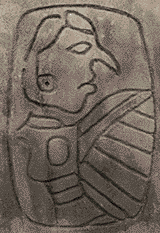
|
|
The mysterious "Birdman" of Cahokia. The Birdman symbolized the union between heaven and earth,
combining aspects of avian (sky) life with human (earth) life. Birdman symbolism figured prominently
in Cahokian religion.
|
 he Cahokians, the tribe after whom the site of Cahokia was named, were actually a subtribe of the Illini who
were inhabiting Cahokia at the time French explorers discovered the area in the 1600s. However, historians
believe that the Cahokians were not the same people as those who founded and lived in what we now know as
Cahokia. For ease of discussion, however, we will continue to refer to the ancient builders of this
magnificent city as the Cahokians.
he Cahokians, the tribe after whom the site of Cahokia was named, were actually a subtribe of the Illini who
were inhabiting Cahokia at the time French explorers discovered the area in the 1600s. However, historians
believe that the Cahokians were not the same people as those who founded and lived in what we now know as
Cahokia. For ease of discussion, however, we will continue to refer to the ancient builders of this
magnificent city as the Cahokians.
The original inhabitants of Cahokia lived in the area from approximately a.d. 700 to 1400,
the population reaching as much as 20,000
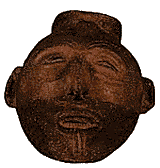
|
|
This Mississippian era human head effigy pot shows evidence of facial tattooing, painting,
and ear piercing for the suspension of ornaments, indicating the same was probably true for
its owners.
Image from
Cahokia: City of the Sun
|
at its peak between a.d. 1100 and 1200. Most archaeologists agree that depletion of natural resources
brought on the decline and downfall of Cahokia, due to the fact that such a large number of people
in a centralized area over centuries of time would have worn out the land, overhunted local wild game,
and used up all available timber for both cooking and construction. Cahokia was at its peak between a.d.
1000 and 1200, but went into decline soon thereafter and was abandoned around a.d. 1400.
The early Cahokians (see the
Cahokian timeline
in part I) were primitive hunter-gatherers who moved into the area of the Mississippi Valley known as the "American
Bottom" around 700 a.d. They replaced the previous inhabitants, a subgroup of Woodland Era Indians known
as the Adena, who had lived there for centuries before, though it is not known whether or not the Cahokians
were an invading people or an outgrowth of the existing Woodland peoples. Either, way, they followed many
of the ways of their Woodland predecessors, and benefited from the ideal location.
Not only did the emerging Mississippians at Cahokia have the benefit of favorable conditions in the
American Bottom, but they also profited from contact with other cultures that had developed throughout
North America. Interaction with nomadic people on the Plains, forest dwellers in the Northeast, and
other Mississippians in the Southeast gave the Cahokians resources and ideas they used to improve
upon what they found around them. From their central location, they traveled vast distances, walking,
running and canoeing along trade routes already established by the Woodland and, to some extent, by
the Archaic peoples. They got copper from the Upper Great Lakes, mica from the southern Appalachians,
and seashells from the Gulf of Mexico. And in the process of obtaining these exotic materials, they
observed traditions and lifestyles they would incorporate into their own.1

|
|
From the
Cahokia Museum
—
Left: Axeheads, some made of copper.
Center: Copper was used for a wide variety of uses, including tools and jewelry.
Right: Arrowhead and spear points.
|
These cultural contacts are clearly evident in all aspects of Cahokian life, from the food they ate to
the temples where they worshiped. The stepped pyramid concept was common throughout South and Central America
long before the Cahokians built their primary temple mounds. The centralized religious and political
organization were likewise similar to that found in those regions. Furthermore, and perhaps most importantly,
their primary source of food — corn — had originally been utilized on a large-scale agricultural basis
by the ancient Mexicans some 4000 years earlier. And without the large-scale agriculture that corn allows,
the city-state model — on which Cahokia was based — cannot succeed. The evidence, therefore, points toward
a South or Central American point of origin for the Cahokians, as all aspects of their culture appear to
have been based upon the same model as the cultures of those regions. This might also be true of ancient
Aztalan,
covered in the
Winter 1998 issue
of Mysterious World, which was remarkably similar in organization to Cahokia.

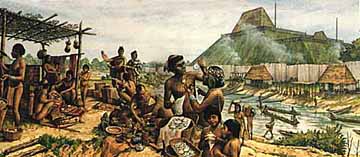
|
|
"Everywhere there are people carrying burdens; cultivating gardens; preparing meals; striking
a bargain for some goods from far away; conducting ceremonial dances; playing games with
either sacred or gambling intent, or both; and, in short, living their daily lives in the
metropolis."2
Image from
Cahokia: City of the Sun
|
At its peak, Cahokia lay at the center of a vast trade network that spread all over the Midwest, Southeast,
and South. Wherever the Mississippi and its tributaries reached, there was likely trade with Cahokia.
As such, most experts on the region believe that Cahokia served as a gateway of trade and cultural exchange
for the entire region. As Kelly explains,
Cahokia has drawn attention as a unique archaeological site since the early 1800s. In addition to its
overwhelming size and complexity, it is a relatively early center on the northern edge of Mississippian
developments. For the northern American Bottom, Cahokia is the focal point of a Mississippian settlement
system consisting of at least eight other mound centers along with numerous other Mississippian settlements.
Cahokia can be viewed as the result of developments termed Emergent Mississippian that occurred
throughout the central and lower Mississippi River Valley between a.d. 800 and 1000. These events
included increases in population, the appearance of a ranked social organization, the establishment
of maize as a major component in the diet, and intra- and extraregional trade.3
Cahokian society was based upon the family unit, which served as the basis of community organization.
Extended families lived in clusters of modest, single-room huts, 20 feet square, made of a framework of
wooden poles lashed together by saplings and roofed with thatched prairie grass. They also constructed
numerous community buildings, including council lodges, neighborhood meeting places, food storage
buildings, sweatlodges, and other special-purpose buildings, much like our modern cities. The most
impressive buildings were the temples and government houses, which sat atop the major mounds. These
buildings were inaccessible to the average Cahokian, and their height served as visible reminders of
the average man's status within Cahokian society. Surrounding the central portion of the city was a
stockade wall, in structure and usage the same as that built by the peoples of
ancient Aztalan.
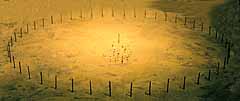
|
|
Diorama of the Woodhenge, showing it at its latest stage of development.
From the
Cahokia Museum
|
Another important structure that is not immediately visible to the casual visitor is the Cahokian's
ritual calendar, more commonly referred to as the "Woodhenge". Named after Britain's "Stonehenge"
the Cahokian Woodhenge performed much the same function. By marking the days and seasons for harvest
and rituals, the Woodhenge, along with Monk's Mound, lay at the center of Cahokian religious life.
However, it would not be proper to distinguish between religious and secular life in the Cahokian
worldview as, unlike today, the distinction between the secular and religious simply did not exist.

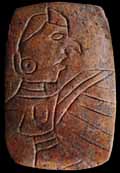
|
|
The "Birdman" tablet, with inscriptions on the front and back illustrating the dualistic,
heaven/earth dichotomy in Cahokian religion. Rollover the image to see the snake's skin
on the reverse of the tablet.
Images from
Cahokia: City of the Sun
|
Besides being the center of society, economy and politics in the American Bottom, Cahokia was also
very likely the center of religious activity. "Cahokia, more than any of its contemporary,
"Mississippian" neighbors, was a vortex of native social, political, economic, and religious
activity."4 At the center of Cahokian theology stood the Birdman,
which stood in opposition to the serpent. The birdman stood for heaven, order, and light, and was
represented in Cahokian society by the king. The king lived at the summit of the main mound at Cahokia,
Monk's Mound, where he was likely believed to be the incarnation of the Birdman — or at least his
earthly representative.
The serpent, on the other hand, stood for earth, disorder and darkness, and was represented by the
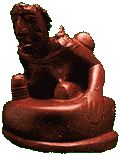
A figurine of a woman with a hoe, cultivating the back of a cat-faced serpent, a symbol
of the earth. The serpent's tail splits into two squash or gourd-bearing vines, which
climb up the woman's back.
Image from
Cahokia: City of the Sun
|
Cahokian people. The Cahokian people lived and worked close to the land, and were more closely in
contact with the land on a daily basis. As such, their role in the Cahokian worldview was to till
and subdue the powers of disorder in the land according to the directives of the king.
In this heaven/earth dualism, the rulers and
the ruled worked together to balance the ideals of religious and political vision with the realities
of everyday life, in order to create a life that was liveable. Heaven and earth, order and chaos,
light and dark, the Birdman and the serpent formed a dualism that neatly summarized the religious
beliefs of the Cahokians.
Scholars who study ancient religion and society tend toward the belief that this heaven/earth dichotomy
was created and maintained by the king and the priesthood in order to maintain close control of
Cahokian society. As Emerson explains in Cahokia and the Archaeology of Power,
Persuasion is as critical a factor as force in the construction of hegemonic control. This
persuasion may take the form of a dominant ideology that shapes and naturalizes a society's
vision of the cultural and natural worlds surrounding it. In the hands of the elite, this
ideological vision seeks to ensure the reproduction of the social and political order. This
reproduction is accomplished through the symbolic representations of sacred landscapes,
individual and warrior power, and the community-centered recreation of ceremonial presentations
of powers to the elite by cosmic forces.5
Through the identification of the king with the ruling powers of the air, symbolized by the Birdman,
the Cahokian king and his priesthood were able to form a ruling body which had de facto
control over much of what is now North America.

The evidence brought to the table by archaeologists and anthropologists make it clear that Cahokia
was the major center of religious, social, economic, and political organization for the entire region
of the American Bottom. The first known major city-state in North America, Cahokia, was not nearly as
large, powerful, or highly developed as its cousins in the south, but it reflected many of their
characteristics in the most fundamental ways. From their reliance on corn as a primary source of
nutrition to the construction of elaborate stepped pyramids, the Cahokians were every bit the
North American equivalent of the ancient Aztecs or Maya. As such, Cahokia should well be considered
the forgotten jewel of the Midwest. 


Cahokia Mounds State Historic Site, administered by the Illinois Historic Preservation Agency, is
just eight miles from downtown St. Louis near Collinsville, Illinois, off Interstates 55-70 and 255, and
Illinois 111, on Collinsville road. It is open daily free of charge, although a donation of $2 for adults and
$1 for children is suggested. Call (618) 346-5160 for more information or a 2000 Calendar of Events.

 Official Cahokia Mounds Site
Official Cahokia Mounds Site
 Illinois Historic Preservation Agency: Cahokia Mounds
Illinois Historic Preservation Agency: Cahokia Mounds
 Cahokia page hosted by School District 54 in Schaumburg, Illinois
Cahokia page hosted by School District 54 in Schaumburg, Illinois
 A Select Bibliography of Published Cahokia Archaeology
A Select Bibliography of Published Cahokia Archaeology

1
Claudia G. Mink, Cahokia: City of the Sun. (Collinsville, IL: Cahokia Mounds Museum Society,
1992), 13.
2
Melvin L. Fowler, The Cahokia Atlas: A Historical Atlas of Cahokia Archaeology.
Revised Edition. (Urbana, IL: University of Illinois Press, 1997), 10.
3
John E. Kelly, "Cahokia and Its Role as a Gateway Center in Interregional
Exchange," in
Cahokia and the Hinterlands: Middle Mississippian Cultures of the Midwest,
eds. Thomas E. Emerson and R. Barry Lewis (Urbana, IL: University of Chicago Press, 1991), 61.
4
Timothy R. Pauketat and Thomas E. Emerson, "Introduction: Domination and
Ideology in the Mississippian World," in
Cahokia: Domination and Ideology in the Mississippian World.
eds. Timothy R. Pauketat and Thomas E. Emerson (Lincoln, NE: University of Nebraska Press, 1997), 1.
5
Thomas E. Emerson,
Cahokia and the Archaeology of Power.
(Tuscaloosa, AL: The University of Alabama Press, 1997), 193.
Cahokia: Forgotten Jewel of the Midwest Part I
Editorial
|
Fragments
|
Cahokia II
|
Piasa Creature II
|
Sphinx III
Register
for our Hall of Records Newsletter!
Questions? Comments? Suggestions? Advertising? Press Releases?
Contact us!

Books

 Cahokia: City of the Sun:
Cahokia: City of the Sun:
Prehistoric Urban Center In The American Bottom
Claudia G. Mink
Rating:
    
Cahokia Mounds State Historic Site preserves the remains of the most
sophisticated prehistoric Indian civilization north of Mexico, circa A.D.
900-1300. Designated a UNESCO World Heritage Site in 1982,
Cahokia is noted for its important role in the prehistory of North
America. This book, written for a general audience, introduces the reader
to this ancient metropolis, with its towering 100 foot-high Monks Mound
and American Woodhenge sun calendar. This is the astounding story of
an advanced Indian culture in North America that thrived and then
declined before European contact. Compact and readable, this book is personally
recommended by the publisher as the perfect starter book for those interested
in further study of Cahokia.
Click
here
to buy this book.
 The Cahokia Atlas:
The Cahokia Atlas:
A Historical Atlas of Cahokia Archaeology
(Studies in Archaeology)
Melvin L. Fowler
Rating:
    
This book is an excellent and very well written introduction to Cahokian history, archaeology,
topography, and everything the casual and advanced reader might want in a book about Cahokia.
Very readable and well illustrated, this book is personally recommended by the publisher.
Click
here
to buy this book.
 Cahokia and the Archaeology of Power
Cahokia and the Archaeology of Power
Thomas E. Emerson
Rating:
   
"Much of the work in the rich flood plain known as the American Bottom has
focused on the huge Mississippian center of Cahokia and other large mound
sites. Emerson opts to evaluate the radiation of chiefly power into the rural
communities, and how these were transformed as the power of elites at
Cahokia waxed and waned. His work is further distinguished by its focus on
ceremony and ritual as cornerstones of elite power....Another major strength
of the volume is its approach to settlement analysis....North American
archaeologists are caught up in a period of exciting (and mostly civil) debates
about the political economy of Mississippian societies. Cahokia and the
American Bottom in particular have become an important testing ground for
evaluating competing ideas about the nature of chiefly power. Emerson's work
reflects the growing sophistication of the approaches being brought to bear on
this issue and is to be commended for its thoughtful articulation of method and
theory."
Click
here
to buy this book.
 Cahokia: Domination And Ideology In the Mississippian World
Cahokia: Domination And Ideology In the Mississippian World
Timothy R. Pauketat (Editor), Thomas E. Emerson (Editor)
Rating:
   
About one thousand years ago, Native Americans built hundreds of earthen platform mounds, plazas,
residential areas, and other types of monuments in the vicinity of present-day St. Louis. This
sprawling complex, known to archaeologists as Cahokia, was the dominant cultural, ceremonial, and
trade center north of Mexico for centuries. This stimulating collections of essays casts new light
on the remarkable accomplishment of Cahokia. The nine contributors explore a wide range of topics —
religion, trade, the nature of local and regional ideologies, social organization, subsistence,
mound construction, and the longstanding question of Cahokia's relationship to later Mississippian
chiefdoms across the Southeast. Cahokia emerges from this book as a significant focal point of
eastern native history. It was prominently situated at the center of a vast regional network that
was simultaneously ideological, religious, and economic — an intricate system of thought, ritual
and power whose effects were felt for centuries.
Click
here
to buy this book.
 Cahokia and the Hinterlands:
Cahokia and the Hinterlands:
Middle Mississippian Cultures of the Midwest
Thomas E. Emerson (Editor), R. Barry Lewis (Editor)
Rating:
   
This fascinating look at one of the most important archaeological sites in North America brings
together the latest research by active Mississippian scholars within the Upper and Central
Mississippian Valley. It details the rise of a complex prehistoric society that influenced
cultures throughout the Midwest. This volume is illustrated with maps, drawings of artifacts,
charts, tables, and photographs. Its contributors cover topics as wide-ranging as cultural
history, the development of social ranking, regional cultural variation, cultural taxonomy,
economic modeling, craft specialization, settlement patterns, models of frontier development,
and agricultural and subsistence systems. Their work will contribute much to the understanding
of the rise of chiefdoms and stratified societies and the development of trade throughout the world.
Click
here
to buy this book.
 The Ancient Splendor Of Prehistoric Cahokia
The Ancient Splendor Of Prehistoric Cahokia
Sidney G. Denny, Ernest L. Schusky, John Adkins Richardson (Illustrator), John D. Richardson
Most books on Native American culture concentrate on the periods
just before, during, and after contact with European civilization. This one,
however, offers a glimpse of American life in a much earlier period. The
authors believe that the Cahokia Mounds site in southern Illinois "represents
the most complex social and political culture of prehistoric North American
Indians." The book describes the archaeological finds and the layout of
Cahokia, relates it to other sites in the U. S. and Mexico, and discusses the
deductions made about the people who lived at Cahokia and the mysteries
that remain. The black-and-white illustrations, mainly drawings with a few
fuzzy photographs, vary in style and in quality of reproduction. Although the
pictures add interest to the text, the practice of captioning them only in the
appended list of illustrations limits their usefulness, especially for children.
Despite these drawbacks, the book provides a basic introduction to Cahokia
Mounds. That alone will make it a useful addition to libraries, particularly in
the Midwest.
Click
here
to buy this book.
 Lost Cities of North and Central America
Lost Cities of North and Central America
David Hatcher Childress
Rating:
   
One of the popular "Lost Cities" series, this book is a must-have guidebook for mysterious places
in North and Central America. I enjoy Childress' books mainly because he comes across as very honest,
although he engages in too much speculation to be taken at face value. Overall I find his books a
very engaging read, and the speculative aspect, though often unscientific, is very entertaining.
Moreover, the amazing amount of study and travel he has done brings a certain amount of
credibility to his work. I highly recommend the "Lost Cities" series of books both for their
refreshingly informal approach and for their "infotainment" value. These books are
definitely not for the timid, and certainly not for the closed-minded.
Click
here
to buy this book.
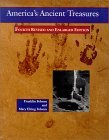 America's Ancient Treasures: A Guide to Archaeological Sites
America's Ancient Treasures: A Guide to Archaeological Sites
and Museums in the United States and Canada
Franklin Folsom
Rating:    
America's ancient treasures (1993 edition) is a reprint of a classic first printed back in 1971. It contains a thorough recounting of every major and most minor Native American archaeological sites and museums in North America, and is an excellent resource tool for those interested in a serious exploration into North America's ancient past. (Review by Mysterious World)
Click
here
to buy this book.
Alexander Von Humboldt, Colossus of Exploration
Ann Gaines, Michael Collins (Photographer)
Click
here
to buy this book.
Audio

 Serpent Mound
Serpent Mound
Rusty Crutcher
Rating:
   
Crutcher's "Serpent Mound" is an excellent blend of piano and keyboards, Lakota flute, ocarina, and
exotic percussion, plus subtly blended environmental recordings. I highly recommend this CD as one
of the best of its genre I have heard. (The background music on this page is from "Osa", the first
track of this CD.)
Click
here
to buy this CD.
 Koyaanisqatsi: Life Out Of Balance (Soundtrack)
Koyaanisqatsi: Life Out Of Balance (Soundtrack)
Philip Glass
Rating:
   
The movie Koyaanisqatsi, released in 1983, was — and is — one of the most amazing pieces
of cinematography ever done. The basic idea behind the film is that modern man is "out of balance"
with nature. And this imbalance, according to Hopi prophecy, will cause the great civilization that
we now live in to destroy itself in a fiery holocaust — again.... Though the film is visually stunning,
by far the best part of the movie, without which the movie would be unwatchable, is the brilliant
soundtrack by Philip Glass. Incorporating Hopi chants with synthesized sound, Glass' soundtrack is
a dark and beautiful work that stands on its own as one of the great movie soundtracks.
Click
here
to buy this CD.
Video

Mound Builders
Rating:
   
From the popular "In Search of History" series, "Mound Builders" gives us a good overall understanding
of the mound building cultures that dominated North America over a thousand years ago. All aspects of
North American mound building are covered.
Click
here
to buy this video.
|
